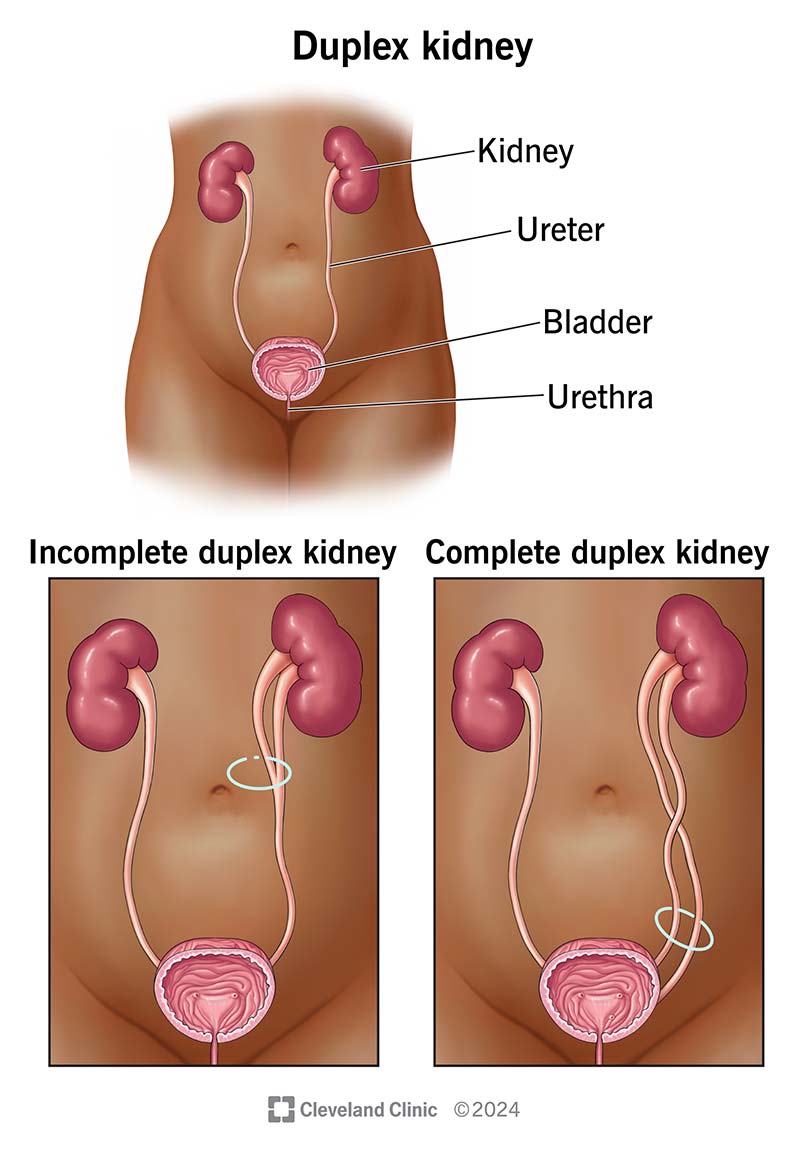Duplex kidney, also called duplicated ureters, is a congenital (present-at-birth) condition where two ureters drain pee from a single kidney. Most people don’t have symptoms or need treatment. Surgery is effective at treating complications that cause symptoms.
Advertisement
Cleveland Clinic is a non-profit academic medical center. Advertising on our site helps support our mission. We do not endorse non-Cleveland Clinic products or services. Policy

Duplex kidney is a condition you’re born with (congenital) where you have two ureters (tubes) — instead of one — that connect one of your kidneys to your bladder. It happens early in development, while your kidneys and ureters are forming. Duplex kidney is also called duplicated ureters or duplicated collecting system.
Advertisement
Cleveland Clinic is a non-profit academic medical center. Advertising on our site helps support our mission. We do not endorse non-Cleveland Clinic products or services. Policy
Ureters are tubes that drain pee (urine) from your kidneys to your bladder. Normally, one ureter leads separately from each of your two kidneys to your bladder. In duplicated collecting systems, two ureters — one in the upper part and one in the lower part — drain a single kidney.
Kidney duplication may affect one or both kidneys (bilateral duplex kidneys). It can also be complete or incomplete.
For most people, duplex kidneys don’t cause symptoms. Symptoms happen when the ureters don’t drain normally into your bladder (more common with complete duplex kidneys). Symptoms of duplex kidney complications include:
No, duplex kidneys don’t cause more pee to drain into your bladder or increase how much you pee. Other body systems control the amount of pee you produce. But if you have a duplex kidney, you might get UTIs frequently, which can cause you to feel like you have to pee more often than you normally would.
Advertisement
When a fetus is developing, cell division errors can cause a duplex kidney. There’s no evidence that anything you do or don’t do during pregnancy causes duplex kidneys.
Yes, sometimes duplex kidney can be inherited (if a parent has it, their child might have it, as well). If one parent has a duplex kidney, any biological children have a 50% chance of being born with it. But kids can have a duplex kidney even if neither of their parents has the condition.
Duplex kidneys usually cause symptoms only when you have other, related differences in the way your urinary system develops. These differences can lead to blockage of the flow of pee (causing it to build up), swelling (hydronephrosis) and/or pee flowing backwards toward your kidneys (reflux). Any of these conditions can lead to repeated UTIs.
Conditions associated with duplex kidney include:
Healthcare providers can see duplicated ureters on imaging tests that get pictures of your urinary tract. While trying to determine what’s causing your symptoms, your provider might ask you about:
Duplicated ureters are usually found during childhood if they’re causing UTIs or incontinence. Some people don’t know they have them until they’re adults — providers might find them while diagnosing a different condition. Symptoms can be similar to other health issues, making it difficult to diagnose.
Your provider might perform the following imaging tests to diagnose a duplex kidney:
Most people don’t need treatment for a duplex kidney. But if you have an ectopic ureter or another issue that’s causing symptoms, you might need surgery on your kidneys, bladder or ureters.
Providers rarely remove a duplicated kidney. If kidney duplication is causing symptoms, surgical options include:
Advertisement
The amount of recovery time you’ll need after surgery depends on your age and which procedure you had. For instance, kids usually stay in the hospital for one to two days for recovery, then continue to rest at home for one to two weeks.
A provider will perform a follow-up ultrasound of your kidney after surgery.
Most people with a duplex kidney don’t have any issues. But if you have conditions like urinary incontinence, pee backing up in your ureter (reflux) or frequent UTIs, you might need corrective surgery.
Having a duplex kidney usually isn’t serious or dangerous. Most people have no symptoms and don’t need treatment.
Duplex kidney isn’t life-threatening and treatments — if you need them — are usually effective at resolving any symptoms.
If you know you or your child has a duplex kidney, keep an eye out for symptoms of conditions that affect your urinary tract (like repeated UTIs with fevers or leaking pee). If you or your child has surgery, be sure to follow all of your healthcare provider’s instructions exactly.
Contact your healthcare provider if you have a duplex kidney diagnosis and have symptoms you think might be related. Ask them what new or worsening symptoms to look out for.
Advertisement
Go to the ER if you have symptoms of a serious infection, including:
It might be helpful to ask your healthcare provider:
Kidney duplication is the most common birth defect (congenital condition) that affects your urinary tract. About 1 in 125 people have either complete or incomplete kidney duplication.
Duplex kidney (duplicated ureters) isn’t a life-threatening condition and doesn’t usually cause symptoms. Many people don’t even know they have it. If you or your child is diagnosed with a duplex kidney and has symptoms, treatment is usually effective at resolving them. While it can be embarrassing to discuss issues like leaking pee or pain when you go to the bathroom, make sure you talk to a healthcare provider about any symptoms — they’re there to help. They can work with you to get to the bottom of your symptoms and recommend treatment to get you feeling better.
Advertisement
If you have a condition that’s affecting your kidneys, you want experts by your side. At Cleveland Clinic, we’ll work with you to craft a personalized treatment plan.

Last reviewed on 02/12/2024.
Learn more about the Health Library and our editorial process.